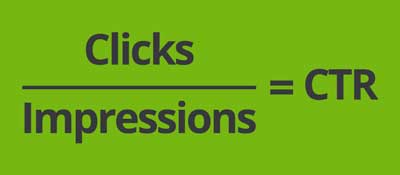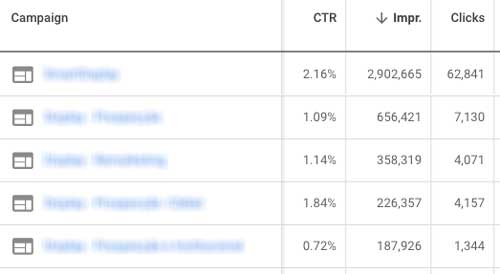In this post, you will learn what CTR is, what a good CTR is, and how CTR influences your Ad Rank and Quality Score. You will also see a scenario where a low CTR might not be an issue.
CTR (Click-Through Rate): definition
CTR is the proportion that shows how often people who view your ad click on it. You can use the CTR to evaluate the performance of keywords and ads.
The formula for calculating CTR is the number of clicks your ad received divided by the number of times it was displayed (which are called “impressions”). Therefore:
Clicks ÷ Impressions = CTR

For example, if you received 15 clicks and had 100 impressions, your CTR would be 15%.
All your ads and keywords have their own CTRs, which you can see in your Google Ads account.
A high CTR is a good indicator that users find your ads useful and relevant. CTR also contributes to your keyword‘s expected CTR, which is a component of Ad Rank.
A “good CTR” is a concept that varies a lot because it is always related to what product or service you advertise and on which networks (Search Network, Display Network, etc.).
CTR can be used to evaluate which ads and keywords are performing well and which ones need improvement.
The more related your ads and keywords are to each other and to your business, the greater the likelihood that the user will click on the ad after searching on your keyword.
CTR helps measure relevance
One of the most interesting aspects of search marketing is the fact that users say exactly what they are looking for. They have already understood they need something and are now trying to find that information, product, or service. When users do a search, they have a question and are looking for an answer. They are expressing a need.
That’s why search engines value high CTRs. The higher the CTR is, the more relevant the search result (be it paid or organic) should be to the user.
Creating a relevant search ad is an essential step for an advertiser to start answering users’ questions. That’s why CTR is very important: it tells us whether users are interested in our ads or not.
As a metric, CTR tells you how relevant users think your ad is. If you have a high CTR, users will perceive your ad as very relevant. If you have a low CTR, users will perceive your ad as not very relevant.
The main objective of each and every PPC campaign is to bring qualified users to your website so they can do something you want, such as making a purchase, submitting a form with personal details, downloading an ebook, etc. Any of these actions are called conversions.
Paying attention to your CTR is an important step to improving your ad’s relevance and getting better visitors to visit your website and increasing conversions.
What is a good CTR?
My clients ask me this question very often. The answer, as is often the case with PPC, is “it depends”.
A good CTR is always relative because it depends on:
- your business sector;
- the keywords you use in your campaign (CTR varies from word to word);
- your campaign settings (CTR varies from campaign to campaign).
Every factor involved counts: from the ad text to the position on the results page. In general, a double-digit CTR (10% or more) is considered very high and therefore very good.
It’s not unusual to see a double-digit CTR on keywords that carry the advertiser’s brand name, mostly when there is a high search volume for that name or for products or services that carry the brand name.
On the other hand, it’s not difficult to see a CTR of less than 3% (i.e. pretty low) on broad match keywords (which tend to be less accurate). Display campaigns can easily have CTRs below 5%.

How CTR influences Ad Rank
CTR is not just an indication of how relevant your ads are to users, it also influences your Ad Rank in search engines. Ad Rank is what determines your ad’s position on the search results page.
The first position does not always belong to the advertiser with the highest bid (the one who is willing to pay the most for the click). It usually belongs to the advertiser with the best Ad Rank and highest bid combined. And CTR is a huge factor in the Ad Rank formula.
Google measures your actual CTR by comparing it to an estimated CTR. So if you’ve run ads with a low CTR in the past, Google will assume that any new ad you create in your Google Ads account will also have a low CTR, and therefore may place you in a lower position on the results page.
That’s why it’s so important to monitor the CTR of your ads and always try to improve it. A low CTR can lead to low positions on the results page, no matter how high your bid is.
How CTR influences Quality Score
Quality Score is a metric of ad relevance that correlates keywords, ad text, and the landing page. The more relevant your ads and landing pages are to the user, the more likely you are to get higher Quality Scores. The Quality Score is calculated by search engines by measuring the estimated CTR, ad relevance, and (user) experience on the landing page.
CTR and your business goals
Given the importance of CTR, should we then optimize all our ads for better CTR and regard other metrics like Conversion Rate as secondary?
No way.
Success in Google Ads campaigns doesn’t just mean having a high Ad Rank and CTR. I could write an ad text saying “Free Apple Watch!”. That would certainly have a very high CTR. But this ad would not help the company increase sales – unless giving Apple Watches for free was a valid goal in the real world…
So you should always focus on your business metrics and goals first, then look at your CTR. If your goal is to sell as many products or services as you can at the lowest possible cost, you can optimize your campaigns around Cost Per Acquisition (CPA).
If your goal is to generate leads at a cost within a certain range, then optimize your campaign around Cost Per Lead (CPL). CTR shouldn’t be your main indicator, except if you are a company whose objective is purely to get a lot of traffic (even if it’s not the most qualified) from your PPC campaigns.
When a low CTR is not an issue
There are cases where a low CTR might be inevitable. One example is when we have to deal with semantically broad, ambiguous keywords. Ambiguity is usually evil in Google Ads. People can search for your product or service using broad keywords, which mean different things to different people and industries.
A good example (among millions) would be the keyword “security”.
Let’s imagine you have a company that offers physical security solutions to other companies, to protect them against theft and invasions. You want to compete on the term “security” to reach people who have recently begun to evaluate security services for their companies. Sounds like a good strategy, and it might be. But “security” can mean several things. Users can use this word to search for:
- Credit card security;
- Data security (computing);
- Home security (alarms, sensors, etc.);
- Human security (who guard banks, buildings, politicians, etc.);
- Financial security.
Those are just five examples that quickly came to my mind right now, so you get the point.
As a second example, let’s say you decide to add the keyword “business security” to your campaign. It’s more relevant, but it’s still a bit of a broad term, and your CTR might not be amazing. But let’s imagine this keyword got you a lot of leads at a pretty good cost. Should you pause it because of the low CTR?
Never! You should always have your final goal as your guide.
A low CTR can be no problem if you’re dealing with broad, ambiguous terms. As long as your keywords and ad text are in sync, performing well, and in line with your business goals, you should be fine.
The takeaway
To get a healthy, high CTR you should always:
- choose the right keywords (relevant terms);
- write relevant, compelling ad copy in perfect sync with your ad group’s keyword list;
- make sure the ad’s destination URL (the landing page) is in line with the ad text, and that it meets the needs of the visitor.
The ideal scenario is having a high CTR on keywords that are:
- relevant: they must be directly related to your ad text, your landing page, and your offer.
- affordable: they must be cost-effective keywords that won’t kill your business’s profit.
